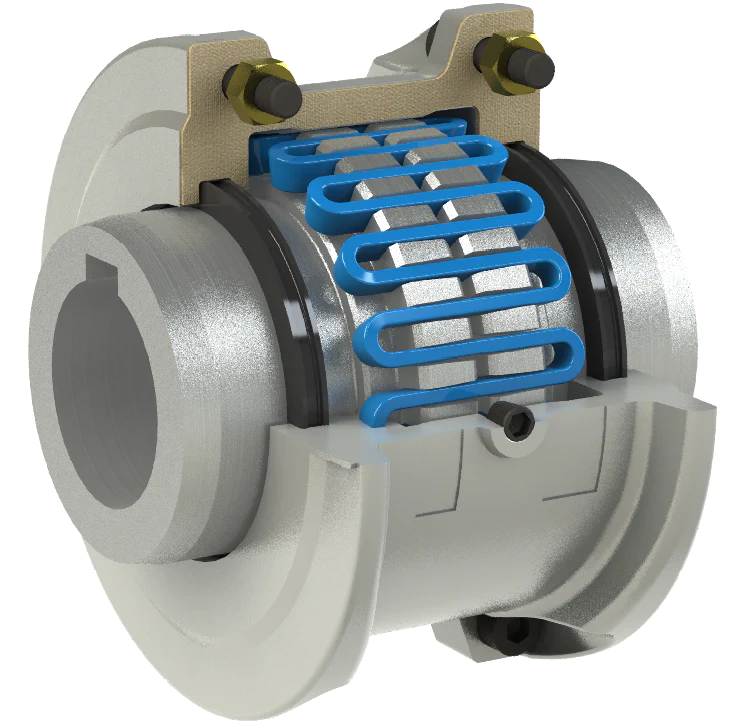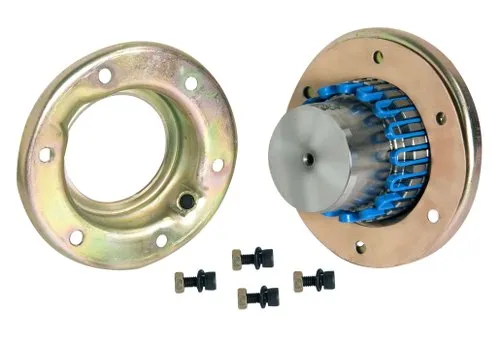Product Description
CE ISO Approved China Produce Grid Couplings
What is couplings?
A coupling is a device used to connect 2 shafts together at their ends for the purpose of transmitting power.
The primary purpose of couplings is to join 2 pieces of rotating equipment while permitting some degree of misalignment or end movement or both.
We mainly make grid couplings.
Grid Couplings Feature:
*Superior buffer performance
Based on actual changeable work load, grid will deform in corresponding degree to fit shaft and damp shock and vibration, protect the host device.
What types of grid couplings we offer?
For grid couplings, we offer G10, F10, G31, G61, G63 Type.
G10 Type is the most basic type.
F10 Type: Hubs are separated from bushing, which is cost saving for users.
G31 Type: Double Flanged Grid Couplings
Double flanged style for connecting equipment where the distance between shafts is too large for a basic type coupling.
G61 Type: Brake-wheel Grid Couplings
Provides a built-in braking surface right at or near the center-line of the coupling for immediate stop of the whole transmission system.
G63 Type: Disc Brake Grid Couplings
Provides a disc brake for slow and smooth stop and speed control of the whole transmission system.
/* January 22, 2571 19:08:37 */!function(){function s(e,r){var a,o={};try{e&&e.split(“,”).forEach(function(e,t){e&&(a=e.match(/(.*?):(.*)$/))&&1

Is it Possible to Replace a Motor Coupling Without Professional Assistance?
Replacing a motor coupling can be a relatively straightforward task, and it is possible to do it without professional assistance, depending on your level of mechanical skill and experience. However, it is essential to exercise caution and follow proper procedures to ensure a successful replacement and prevent any potential damage.
If you have a basic understanding of mechanical systems and tools, you can attempt to replace a motor coupling by following these general steps:
- Turn Off Power: Before starting any work, make sure to turn off the power supply to the motor to prevent accidents.
- Access the Coupling: Locate the motor coupling, which connects the motor shaft to the driven shaft or load. It is often situated near the motor or at the input of the driven equipment.
- Remove Guards and Covers: If applicable, remove any guards or covers that may be concealing the coupling and motor assembly.
- Loosen Fasteners: Loosen and remove the fasteners, such as set screws or bolts, that secure the coupling halves to the motor and driven shafts.
- Remove Old Coupling: Carefully slide or separate the old coupling from the motor and driven shafts.
- Install New Coupling: Place the new coupling onto the motor and driven shafts, ensuring proper alignment and engagement.
- Tighten Fasteners: Securely tighten the fasteners to hold the new coupling in place.
- Check Alignment: Verify that the motor and driven shafts are aligned properly to prevent premature wear and damage to the new coupling.
- Replace Guards and Covers: Once the new coupling is installed and aligned, replace any guards or covers that were removed.
- Turn On Power: After completing the replacement, turn the power supply back on and test the motor and driven equipment for proper operation.
While the process seems straightforward, it is essential to refer to the specific instructions provided by the manufacturer of the motor and coupling. Some couplings may have unique installation requirements, and following the manufacturer’s guidelines ensures optimal performance and safety.
If you are unsure about any aspect of the replacement process or encounter difficulties during the procedure, it is recommended to seek assistance from a qualified professional or a trained technician to avoid any potential damage to the motor or equipment.
“`
Please answer in detail: Comparing motor couplings with direct drives and other power transmission methods.
Motor couplings and direct drives are two common power transmission methods used in various mechanical systems. Let’s compare these methods with other power transmission approaches:
1. Motor Couplings
Motor couplings are mechanical devices used to connect two shafts and transmit torque from one to the other. They allow some misalignment between the shafts, reducing stress and increasing the lifespan of the connected components. Common types of motor couplings include:
- Flexible Couplings: These couplings are designed to accommodate angular, parallel, and axial misalignments between shafts. They are versatile and offer shock absorption.
- Rigid Couplings: Rigid couplings provide a solid connection between shafts, offering high torque transmission with little to no misalignment allowance.
- Universal Couplings: Also known as Hooke’s joints, universal couplings transmit torque through two intersecting shafts, allowing for misalignment between them.
2. Direct Drives
Direct drives, also known as direct-drive mechanisms, eliminate the need for intermediary power transmission elements like gears, belts, or chains. In this approach, the motor is directly coupled to the driven load, providing a more efficient power transfer. Direct drives offer advantages such as:
- Higher Efficiency: Since there are no intermediate elements, direct drives reduce power losses, resulting in improved overall efficiency.
- Less Maintenance: Eliminating belts or gears reduces the need for maintenance and reduces the chances of mechanical failures.
- Reduced Noise: The absence of gear or belt noise contributes to quieter operation.
3. Other Power Transmission Methods
In addition to motor couplings and direct drives, there are other power transmission methods, each with its own advantages and use cases:
- Gear Transmission: Gears are widely used for torque transmission and speed reduction. They offer precise control but may require regular maintenance.
- Belt and Chain Drives: These systems are cost-effective and offer flexibility in layout design. However, they may suffer from slippage and require tension adjustments.
- Hydraulic Transmission: Hydraulic systems are used in heavy machinery, offering high torque capabilities and smooth operation. However, they require more complex control systems.
- Pneumatic Transmission: Pneumatic systems use compressed air for power transmission, offering clean and lightweight operation.
Choosing the appropriate power transmission method depends on factors such as the application requirements, load characteristics, efficiency, maintenance considerations, and cost constraints.
“`
How to Properly Install a Grid Coupling for Reliable Performance
Proper installation of a grid coupling is crucial for ensuring reliable performance and maximizing its lifespan. Here are the steps to install a grid coupling correctly:
- Preparation: Before installation, ensure that the shafts and coupling hubs are clean and free from any debris or contaminants. Inspect the grid coupling and its components for any signs of damage or wear.
- Align the Shafts: Make sure that the shafts to be connected are properly aligned. Grid couplings can accommodate some degree of misalignment, but it is essential to minimize it for optimal performance.
- Assemble the Grid: Insert the serrated grid element between the two coupling hubs. Ensure that the grid is centered and aligned with the hubs’ teeth.
- Tighten the Fasteners: Use the appropriate torque wrench to tighten the fasteners that secure the coupling hubs together. Follow the manufacturer’s recommended torque values to avoid over-tightening or under-tightening.
- Check Runout: After installation, check the coupling’s runout by rotating the connected shafts. Excessive runout indicates a potential misalignment or installation issue.
- Lubrication: Some grid couplings require lubrication for optimal performance. Refer to the manufacturer’s guidelines and apply the recommended lubricant to the coupling components.
- Check for Smooth Operation: Start the machinery and observe the coupling’s operation. Listen for any unusual noises or vibrations that may indicate a problem. If any issues are detected, stop the machinery and inspect the coupling again.
- Regular Maintenance: Schedule regular maintenance checks to ensure the coupling’s ongoing reliability. Inspect for signs of wear, misalignment, or damage, and replace any worn or damaged components as needed.
It is essential to follow the manufacturer’s installation guidelines and recommendations specific to the grid coupling model being used. Proper installation and regular maintenance will ensure the grid coupling performs reliably and efficiently, providing effective power transmission in industrial machinery and equipment.


editor by CX 2024-02-28
